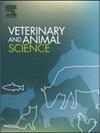饲养富集会影响雏鸡和散养母鸡的栖息行为和骨骼强度
IF 1.9
Q2 AGRICULTURE, DAIRY & ANIMAL SCIENCE
引用次数: 0
摘要
家鸡产蛋率高,对其骨壳腺钙代谢造成很大压力。住房系统的行为和身体影响在小鸡发育期间开始,但在整个产蛋过程中,锻炼对于保持骨骼强度仍然很重要。散养系统可能会提高那些放养较多的母鸡的骨骼强度。本研究评价了在实验落地式猪圈中对雏鸡进行富集饲养的效果。测量了饲养结束时的栖息和振翅行为以及断骨负荷。在整个鸡群周期中观察栖息行为,并在产蛋结束时评估不同范围使用母鸡的骨折负荷。正如预测的那样,与暴露于不同的新物体或对照的小鸡相比,给予它们栖息结构丰富的小鸡更多地栖息。然而,这并不影响幼崽胫骨的断裂负荷。新奇处理的幼崽肱骨断裂负荷最低,但不同处理的扑翼行为相同。在产蛋过程中,新奇处理母鸡栖息最多,产蛋结束时胫骨断裂负荷最高。不同的范围使用模式与胫骨或肱骨的断裂负荷无关。这项研究表明,丰富的饲养环境可以对母鸡的行为和随后的骨骼健康产生长期影响,但在户外度过的时间更长并不会影响骨骼强度。进一步的研究应继续探索在地板饲养系统中提供的营养物对蛋鸡行为和身体的影响。本文章由计算机程序翻译,如有差异,请以英文原文为准。
Rearing enrichment affects perching behaviour and bone strength in pullets and in free-range hens varying in range use patterns
The high laying rates of domestic hens places significant strain on the calcium metabolism in their bones and shell glands. Behavioural and physical impacts of housing systems begin during pullet development, but exercise is still important throughout lay for maintaining bone strength. Free-range systems may improve bone strength for those hens that range more. This study assessed the effects of rearing enrichment for pullets housed in experimental floor pens. Perching and wing-flapping behaviour, and bone breaking load at the end of rearing were measured. Perching behaviour was observed throughout the flock cycle and bone breaking load assessed at the end of lay in hens that differed in range use. As predicted, pullets perched more when they were given perching structure enrichments compared with pullets exposed to varying novel objects or control pullets. However, this did not affect the breaking load of the pullets’ tibias. The novelty treatment pullets had the lowest humeral breaking load, but wing-flapping behaviour was observed equally across treatments. During lay, the novelty treatment hens perched the most and showed the highest tibial breaking load at the end of lay. Differing range use patterns were not correlated with the breaking load of the tibias or humeri. This study indicates that enriched rearing environments can have long-term impacts on hen behaviour and subsequent skeletal health, but that more time spent outside on the range does not impact bone strength. Further research should continue to explore the behavioural and physical effects of enrichments provided in floor-based laying hen rearing systems.
求助全文
通过发布文献求助,成功后即可免费获取论文全文。
去求助
来源期刊

Veterinary and Animal Science
Veterinary-Veterinary (all)
CiteScore
3.50
自引率
0.00%
发文量
43
审稿时长
47 days
 求助内容:
求助内容: 应助结果提醒方式:
应助结果提醒方式:


